Whether you’re shooting for a coffee shop or your food blog, there are a few creative tips you can use.
Try these techniques to improve your coffee photography!
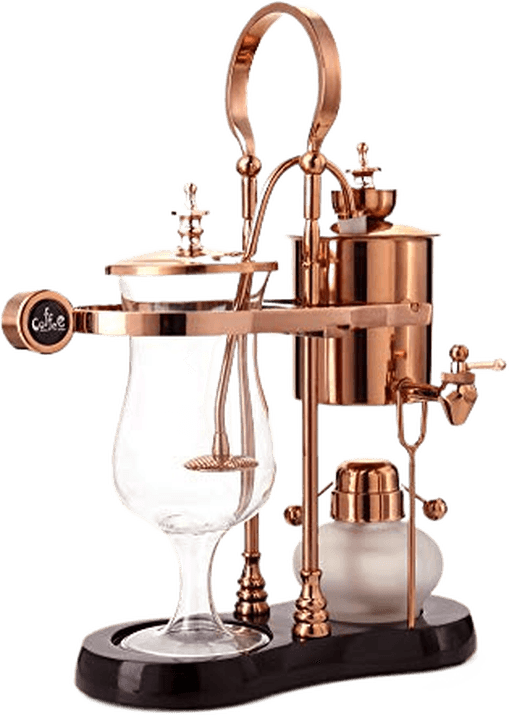
How do you like your coffee? Is it a shot of espresso, hot and intense? Or is it a large mug of latte, milky and tender?
Look at it closer. What do you like about it?
Do you like seeing swirls and curls of coffee and milk merging? A pinch of cinnamon on a weightless cappuccino foam? Or the way strong coffee absorbs light looking almost non-transparent?
Get your macro lens and capture these details with a series of close-up pictures.
There isn’t much room for an elaborate narrative here. But most of the time, a close-up picture of a coffee cup is enough to tell a story.
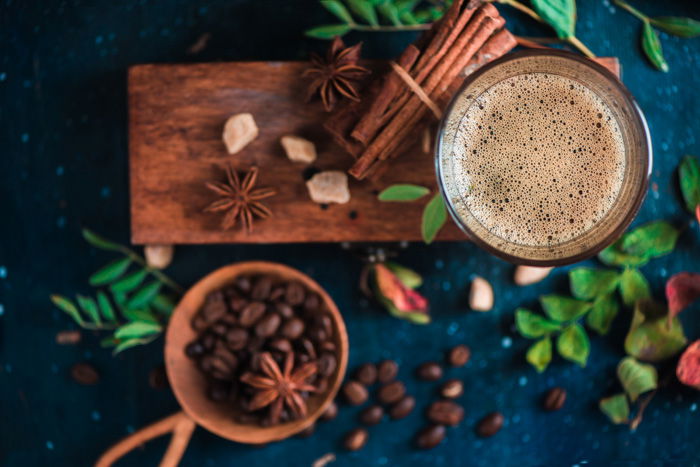
When shooting coffee photography, you can also concentrate on differences in the making of, say, a flat white and a cappuccino.
Compare two ways of enjoying coffee: with or without milk, hot or iced, etc. You can even take it up to eleven and shoot plain, but elegant espresso next to something fancy.
No matter what you decide, keep the scene as minimalist as possible. Bring in only the objects that tell your story.
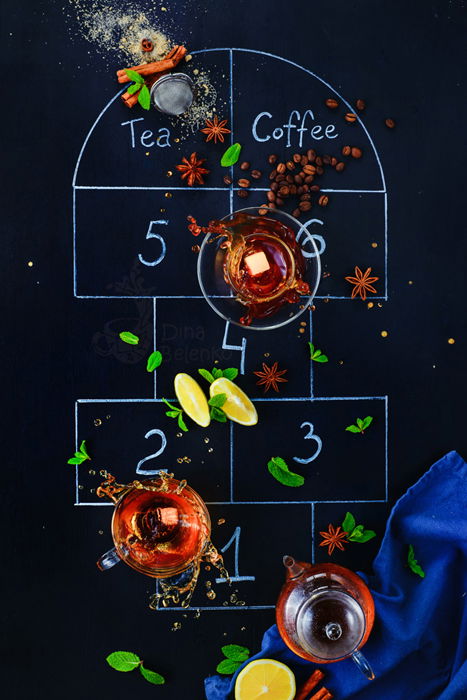
With your pictures of coffee, let your viewers know how to make various recipes by showing the ingredients.
If you drink your coffee with syrup, coconut milk, or chocolate, then include them in the photos. You can even add other ingredients such as cardamom, cinnamon, and coffee beans.
Props are crucial when taking pictures of coffee.
Take a look at some props you already have and use them as your main heroes. You can include anything from vintage coffee grinders to porcelain cups.
Don’t ignore simple porcelain coffee cups. They may seem boring, but they can fit in any story you’re telling.
Cups with patterns or elaborate designs can be hard to match with other props. But plain white porcelain mixes well with everything.
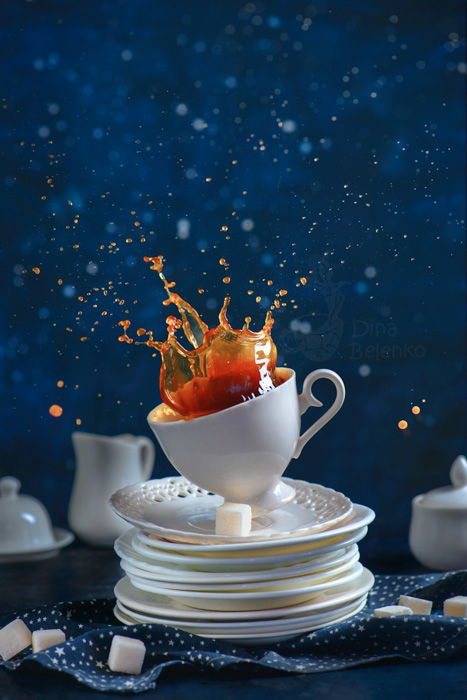
Simple props are perfect when taking pictures of coffee. But feel free to work with something a bit bolder and more vibrant as well.
The color itself can be the main hero of your image. If you’ve got some brightly colored dishware, why not play artist and photograph coffee on vibrant backgrounds?
Add a couple of contrasting details to make your shots more lively, but keep everything simple. Geometrical shapes and color blocking work great together.
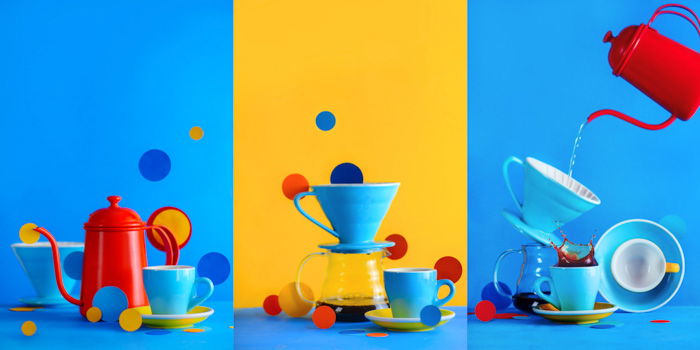
A portafilter may not seem appealing. But add some coffee beans and arabica leaves, and it shines!

I know, not everyone has access to arabica leaves. But you can buy a small coffee plant in a local flower store and grow it at home.
Of course, you shouldn’t just limit yourself with portafilters. A French press looks marvellous in backlight. An old coffee grinder would work great in a dark setting. A Moka pot is fantastic for modern scenes with a minimalist and clean look.
And if you can lay your hands on a siphon coffee maker, it can look stunning in any scene.

Your starting point doesn’t have to be a specific variety of coffee or a type of props. It can be colors you’re going to use. I’m strongly inclined to shoot my coffee in the tradition of dark food photography. Generally, that means using black and brown color palette, backlighting, impressive shadows.
I usually start my images coffee with a dark background. I then gather the appropriate props for the shoot. Coffee grinders, wooden spoons, coasters, and boxes come in handy here. Their brown color matches the color of the coffee, but they’re darker.

When I pick a coffee cup, it’s usually a glass one. It’s easy to match glass texture with practically everything. Or I can take a ceramic mug if I want to go for a more vintage and magical mood.
After that, it’s nice to add coffee splashes of contrasting colors. I often like to combine bright cinnamon and anise, blue napkins or coasters, and maybe some green leaves.
When taking pictures of coffee, I also use some colder colors like blue and green. They add spots of contrast to our warm palette and make it look more balanced.
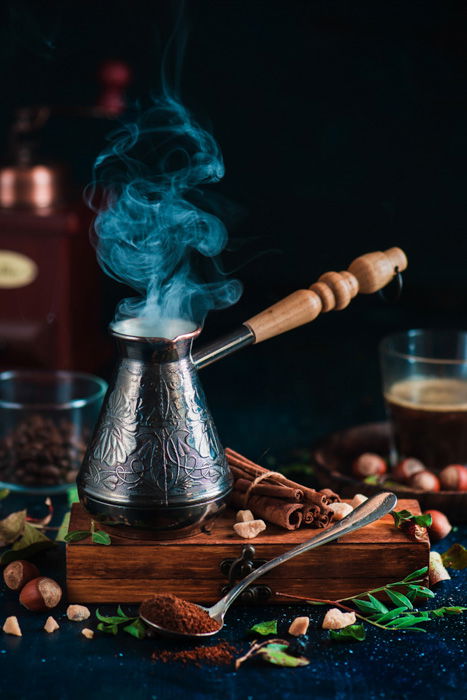
Coffee also works pretty well in high-key photography. Especially if you want to add not only cups and drink, but some roasted beans, you can even add backdrops of a variety of bold colors.
I prefer cold shades like sky blue when taking pictures of coffee. It contrasts the color of coffee beautifully, creating a delicate visual balance.
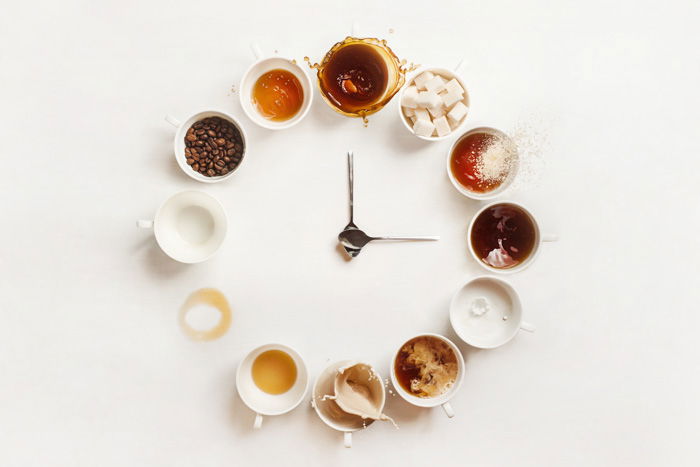
Decide which palette you are going to use before arranging the scene or gathering props.
Try to imagine the resulting picture in your head and catch that mood you’re about to create, whether it’s dark and cosy, light and cheerful or vibrant and bold.
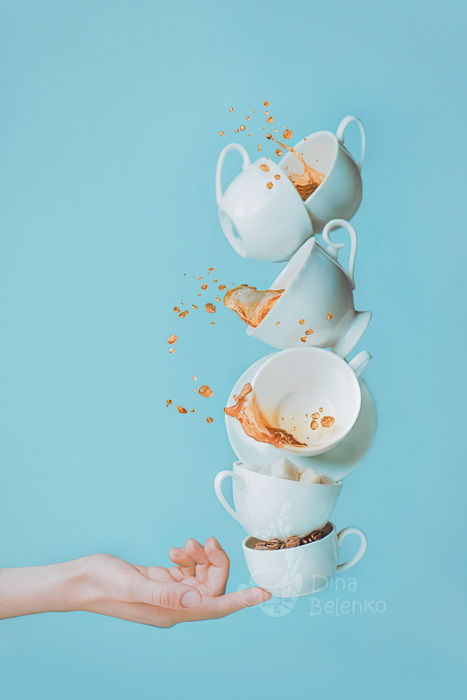
Pictures of coffee don’t have to be only about the drink. Coffee beans deserve your attention too!
Coffee beans are perfect for adding a message to your flat lays. They’re excellent tools for food typography. You can use them alone or combine with words made with cinnamon, anise stars, cardamon, sugar cubes, or cookies.
Using coffee beans, you can wish someone a good morning or even draw a treasure map.
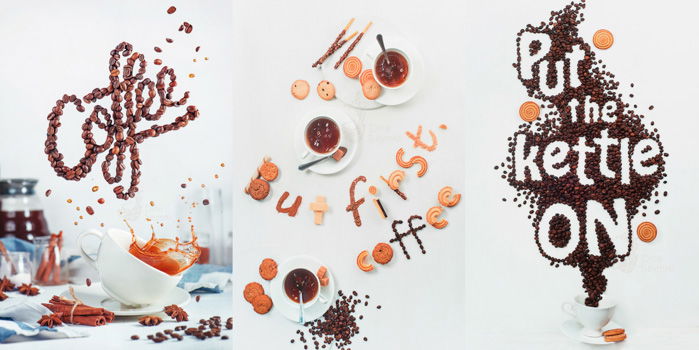
Think about a word or a short sentence you want to say, draw its outline and fill it with coffee beans. This work requires patience, but the result is always worth it.
Just make sure you have enough coffee beans to execute your idea!

This is my favourite kind of coffee photography; the ability to convey a feeling or a mood through a photo.
So how do you create coffee images that say, “It’s Saturday morning, I’ve got a huge mug of cappuccino and a lot of time to be lazy”?
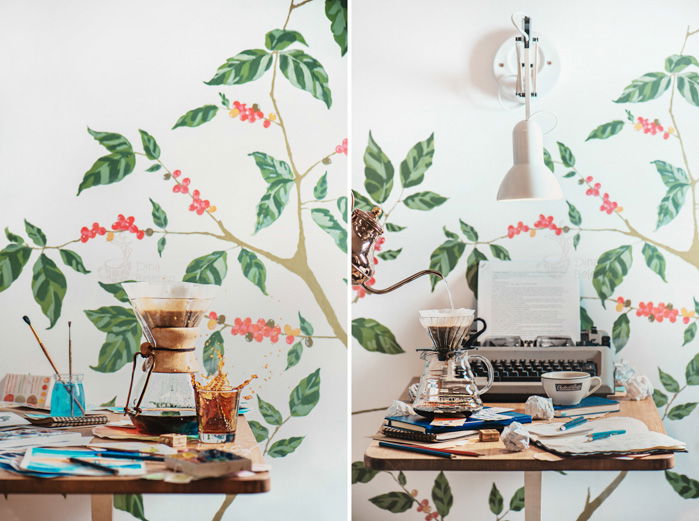
How do you convey the feeling of a Saturday morning through pictures of coffee? Using natural morning light (or a good studio imitation) and a flat lay composition is a great start. Maybe you can include a part of a window in the background. It should also be high-key with lots of room to breathe.
I’ve got a large mug of cappuccino. This one’s easy. Get your coffee. Get something with your coffee to call it breakfast—a doughnut, a croissant, or maybe a bowl of cookies.
Also, where are you having your morning coffee? In bed? In a sunlit kitchen? On a balcony? In a coffee shop with huge windows? You name it.
I’ve got time to be lazy. Good, but what does it mean visually? What are you going to do with your weekend? Will you spend it reading?
Or will you decide to practice drawing and paint a watercolor sketch right inside your favourite coffee shop? Will you just look at the sky from your balcony counting clouds?
Answer that question and bring something to a frame to show that intent—a book, a couple of brushes and sketches, etc.
And voila! You have all you need to create the picture. Now get your props, arrange a composition, and take your coffee photos!
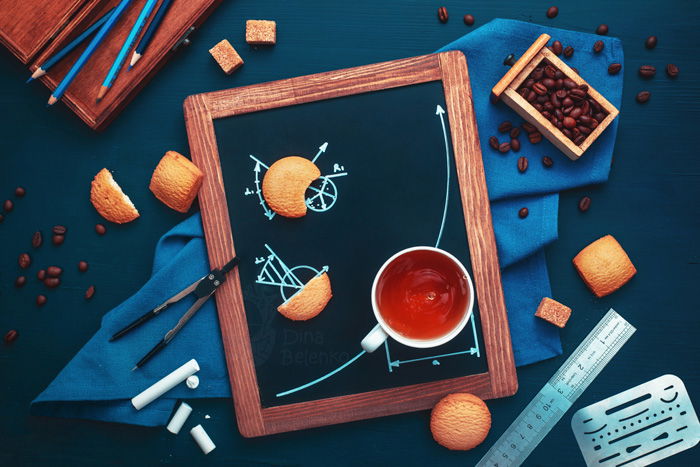
Now, pick your own simple story. Think of time and event.
Where are you? What are you doing? Can you tell what time it is? And, above all, what does it mean visually?
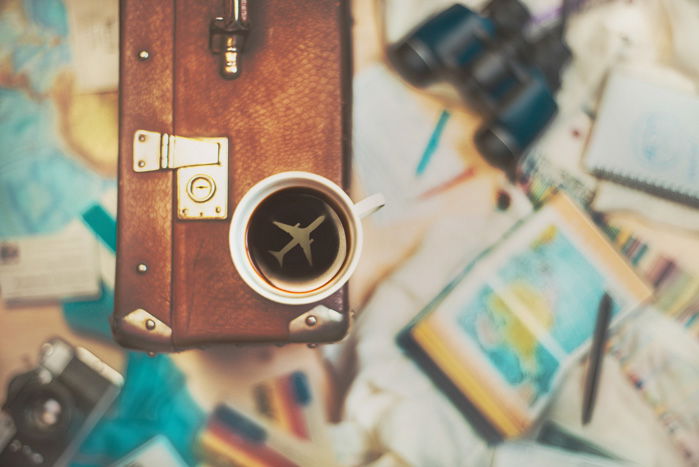
Coffee photography is not about the drink (I know, I’ve said it before).
It’s about your favourite books and movies, your dreams, even you. Take it to the next level and tell stories of your own.

You can step up your storytelling game when it comes to coffee photography. Make a cup of coffee, your lead actor, imagine yourself a director giving orders to coffee beans and cookies. A director who tries to say something to their audience.
We’re entering the waters of conceptual food photography here, but it shouldn’t be scary. After all, we’re just taking pictures of coffee!
There are lots of different ways to come up with an idea for coffee photography. Let’s look at one of them.

First of all, let’s make it personal. Think, what do you like about your coffee? Is it the fact that it gives you an energy boost? Or, in contrast, do you drink coffee to take a break and relax?
In the first case, picture your coffee as a life-saving liquid, a magical potion of strength. Or maybe as something that lets you wake up in the morning, that leads you out of the maze of tangled thoughts.
Gather a bunch of empty coffee cups around a piece of completed work. It could be a painting, a script, a sculpture, or an architectural blueprint. Show that was your alter-ego created during a marathon of working enthusiasm and inspiration.
Maybe you can draw a blueprint of a Rube Goldberg Machine and use a coffee cup as the critical element.
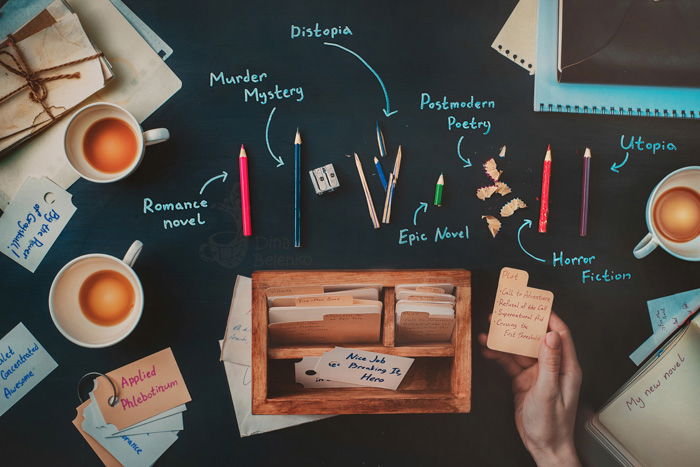
Make a list of all the words that your brain associates with energy and try to pair them with coffee—one by one by one. Find a pair that clicks.
And finally, look for a visual way to express that match.
On the other hand, coffee may make you feel cosy and relaxed. Good! Make the same list, but with relaxation as the keyword. Write down all the stuff that makes you feel comfortable. The top of my list is reading, just sitting down with a good book, without any hurry or time pressure to get work done.
So, how can I combine reading with coffee? Maybe I’m reading a fantasy book and see a dragon in a coffee cup reflection. Or a Middle Age castle formed with hot rising steam. Or I leave a coffee cup on a high stack of unread books. Only to find later lots of stairs and ropes, brought by some tiny folk to reach for my delicious (but alas stale) latte.

Describe the atmosphere you want your viewer to feel in one word. Make this your starting point.
My favourite way to come up with ideas for still life photography is to think of a character for my story. It could be anything from a stargazer, to a pirate or a watchmaker.
Anyone who can have a cup of coffee may be a leading actor in your story. Pick someone with a little spark of adventure inside. Say, your hero is a writer. What will they do? Will they spend a sleepless night looking for a new plot twist at the bottom of a coffee cup?

What if your hero is a wizard’s apprentice, learning how to levitate things? What would an apprentice use for practice? Something simple and affordable: A coffee cup!
If you pick an artist, imagine them working on a lovely watercolor painting and getting very immersed in the process. And, of course, put brushes in a coffee cup by mistake (even the most collected artists do that, believe me).

The critical element to fantastical coffee photos is to combine props that tell a narrative.
If your hero is a steampunk engineer, then use blueprints, rulers, and compasses on the table. Also, zeppelins in steam rising above hot coffee.
Sure, getting props for a steampunk scene is tricky, especially when photographing coffee. But I assure you, you can make do with the bare minimum amount of coffee props! And you can make lots of it yourself.

And last but not least, make your still life photography less, well, still. Dynamic images always look captivating, so why not try and bring your coffee images to life?
The first and easiest way is to shoot coffee while it’s hot and capture beautiful curls of rising steam. Use backlight to make steam not only visible but shiny. Set your camera on continuous mode. Pour some boiling water into a coffee cup and take a sequence of shots with rising clouds of steam. Keep the kettle a bit higher than usual so that it won’t get into the frame.
Be careful with hot water and watch for the safety of any electronic equipment. And check out our tutorial on shooting smoke to get the lighting scheme and some useful tips.
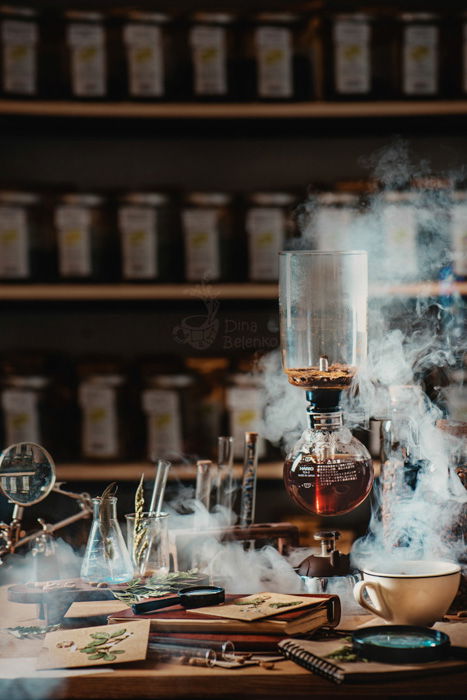
A slightly harder way to add action in coffee photography is to shoot splashes. For your first try, I recommend shooting from the side, using a smooth background, and dropping a sugar cube into a cup.
Shooting from above is a bit trickier because if you need another iteration, you can’t just merge a clean shot and the splash shot. You would need to clean up the background first.
But don’t worry, we have another tutorial, specifically about shooting splashes, check it out! Photographing coffee splashes is easier than it looks, I promise.
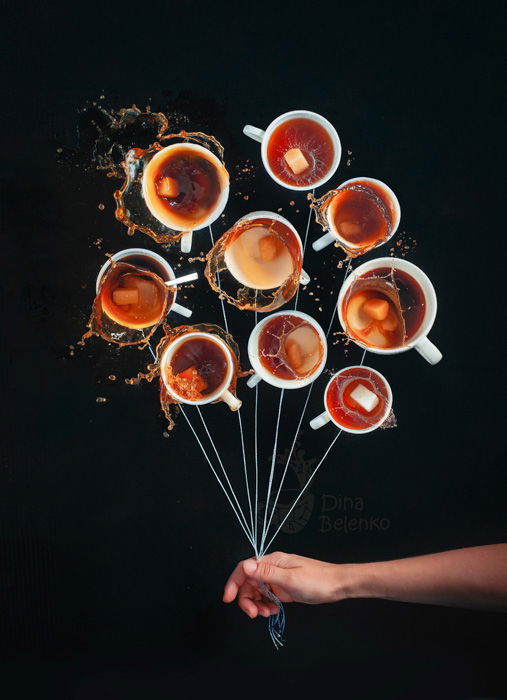
Coffee is an excellent subject for a photographer like you! You can use it for anything from regular food photography to conceptual still life photography.
A cup of coffee may seem simple. But it can take you anywhere, such as a scientist’s lab or even a wizard’s study!
Seize this opportunity to talk about your dreams and adventures. Drink coffee, take beautiful pictures, and stay inspired!
For all the best food photography tips, read our eBook – Edible Images!
